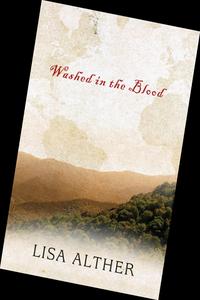

Washed in the Blood is the latest novel by Kingsport native Lisa Alther. The novel begins in 1567 in the American Southeast in the area the Spanish called La Florida and ends in Southern Appalachia in the mid-twentieth century.
Although the term Melungeon is never mentioned, Alther is telling her version of the Melungeon story - when and why Mediterranean/Europeans came to North America with Spanish conquistadors; how the mixing of Spanish, Portuguese, African, and/or Native American people could have occurred; and what happened to these people of mixed ancestry as the United States took shape.
The evidence of thorough research makes this novel unique among the many stories with Melungeon characters written by authors ranging from Kentucky's Jesse Stuart to Big Stone Gap's favorite daughter, Adriana Trigiani.
The Melungeons have fascinated storytellers for more than a century. Most of these novelists base their characters and plot turns on one printed article or book. However, Alther weaves the growing body of Melungeon scholarship and elements from the popular press together seamlessly into the lives and loves of three winsome young heros-Diego, Daniel, and Will.
Alther portrays three time periods: 1567, when the Spanish lusted for the yellow metals and tried to conquer the native peoples; 1837-38, when the Cherokees of Appalachia walked the Trail of Tears; and early twentieth century, when irrational functionaries in Virginia practiced eugenics and attempted to draw a firm color line to classify all people as either "colored" or white. Other important historical events - like the Spanish Inquisition, the Battle of King's Mountain, and the ravages of the War Between the States as played out in Appalachia - are woven into the main plot through stories the characters tell.
Two themes and a narrative strategy tie the stories together. The strategy is the way Alther chooses to tell them. Readers experience events, people, and colliding value systems through the perceptions of three young men, each of whom is thrust into new situations that challenge things they thought they knew about themselves and how the world works.
• When Diego, a hog drover for a Spanish exploring party, is left behind at a fort, he learns that he cannot return to Spain because his parents were Jews and have been burned at the stake by Spanish Inquisitors. His life in the New World, with an African girl he bought and the Native Americans who view women as equals in wisdom and value, stretches before him as the 1567 section of the novel closes.
• Daniel Hunter, an idealistic Quaker missionary who starts a backwoods school in Appalachia in 1837, confronts the ugly realities of bounty hunters chasing fugitive slaves, the heartbreak of the Cherokee removal from the mountains, and the injustice of land grabbers with paper deeds who steal from the illiterate racially mixed people who have "owned" the land for centuries. Violence is necessary to insure rudimentary order. The Quaker platitudes of "fighting evil with good" and "turning the other cheek" lack utility in his new world.
• Will Martin, with six fingers on each hand, grew up on Mulatto Bald. He knows the stories of "Porterghee Indians" from his grandmother and experiences the prejudice of the town kids as he is growing up. But his real wake-up call is being thrown off a city bus for being "colored" when he is a medical student in Virginia. His rise to respectability as a physician in Holston, Tennessee (a loosely disguised depiction of Kingsport) is jeopardized when his illegitimate son comes to town needing shelter and nurture. Will lives in fear that someone will discover his past and tell him once again that he is not white enough.
The first of two themes revolves around a magnificent ruby on a gold chain. Diego's Uncle Lucas carried the pendant in a leather pouch for months before giving it to his nephew along with of the story of Diego's real parentage. The ruby, "a jagged black pebble with dull reddish veins," shows up in every section of the novel, passed down to girls named Galicia in the Martin family. Galicia Hunter, granddaughter of Galicia Martin (1837) marries Will Martin (1911), and treasures the stone. This contemporary Galicia puzzles over both her first name and the jewel's origin: "She liked it all the same. It made her feel connected to those unknown ancestors." Galicia Hunter does not know much about the ancestors, but readers do; and the resulting tension adds to the pleasure.
Galicia and Will illustrate the second prominent theme, that of close relatives marrying each other. Some characters in the stories know they are related. Some do not. The six fingers persist as evidence of the too-close blood kinships. This theme resurfaces in the final pages; telling how would spoil the book for readers.
Washed in the Blood could be Alther's best Appalachian novel yet - rich, measured, insightful, and poignant. The times when life was precarious for people of mixed ancestry are touchable through the characters and their stories. You share their struggles, and their fears make your gut twist. This book is a great read!
About the Reviewer: Katie Vande Brake is Dean of the School of Arts & Sciences at King College, where she has taught English and Technical Communication since 1980. She researches Melungeons, focusing on their present (their depiction in fiction, literacy, and Internet presence) rather than origins or history. Her study of Melungeon characters in Appalachian fiction, How They Shine, was published in 2001. A second book, Through the Back Door: Melungeon Literacies and Twentieth Century Technologies, was released in 2009.